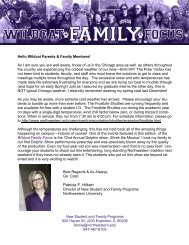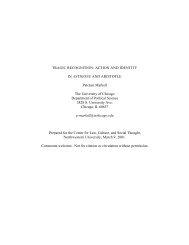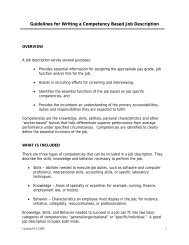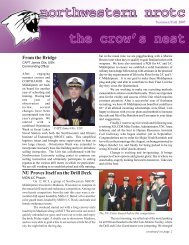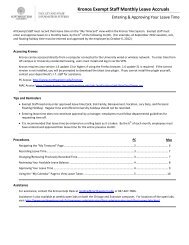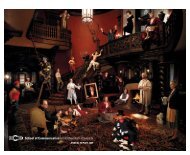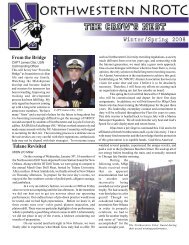Artistry Permits and Custom May Ordain - Northwestern University
Artistry Permits and Custom May Ordain - Northwestern University
Artistry Permits and Custom May Ordain - Northwestern University
You also want an ePaper? Increase the reach of your titles
YUMPU automatically turns print PDFs into web optimized ePapers that Google loves.
183 See Trillo’s treatment of revolving male attitudes towards the ornamentation of the kanzu. 22-4.<br />
40<br />
spans. 183 By the same token, the most popular modern style of dress for women, the kanga<br />
or leso, seems to share similarities with earlier manners of dress, but it lacks a direct design<br />
antecedent <strong>and</strong> has itself been modified since its introduction. 184 The impetus for these<br />
modifications is useful as a mirror of larger social change, particularly since fashion remains<br />
a measure of respectability to this day. Aesthetic choices <strong>and</strong> ideas of beauty were (<strong>and</strong><br />
are) in constant motion, adjusting to a wide range of interactive internal <strong>and</strong> external<br />
dynamics <strong>and</strong> incorporating varying themes <strong>and</strong> designs. The resulting fashions have<br />
remained discernibly Swahili in character even while changing in time <strong>and</strong> space. 185<br />
Predictable patterns of consuming cloth—both domestic <strong>and</strong> foreign—bound the Swahili<br />
world together <strong>and</strong> revealed the parameters of its taste, style, <strong>and</strong> notions of status. The<br />
result was a generalized Swahili-ness that varied only by the level of consumption. 186<br />
Swahili aesthetics pertaining to culturedness (uungwana) have changed radically over<br />
time, but the idea of a culturedness has never been challenged. Throughout, cloth has<br />
stood out in the world of goods as an essential ingredient in maintaining, reproducing,<br />
<strong>and</strong> recreating identity.<br />
Who in their splendor shone like the sun itself 187<br />
4 �� Swahili rulers <strong>and</strong> the symbolic vocabulary of state consumption<br />
The state—comprised of the sultan(a) <strong>and</strong> his/her wazir, amir, <strong>and</strong><br />
counsel—consumed cloth <strong>and</strong> other items of prestige on a gr<strong>and</strong> scale. 188 Royalties within<br />
184 On the popularization of the leso/kanga see Trillo, “Fashion <strong>and</strong> Fabrics,” 18-22; D. Amory, “The Kanga Cloth<br />
<strong>and</strong> Swahili Society: Mke ni Nguo,” Paper Presented to Yale <strong>University</strong>, Scholar of the House Program, 1985; <strong>and</strong><br />
Strobel, Muslim Women. 174.<br />
185 I would extend this notion of selective aesthetic incorporation to include all items of material culture,<br />
particularly in the eighteenth <strong>and</strong> nineteenth centuries when Swahili material culture was incorporating an<br />
unprecedented number of foreign stylistic variations. J. de Vere Allen frames plasterwork <strong>and</strong> woodwork in this<br />
light in “Swahili Culture Reconsidered: Some Historical Implications of the Material Culture of the Northern<br />
Kenya Coast in the Eighteenth <strong>and</strong> Nineteenth Centuries,” Azania. 9 (1974): 105-38.<br />
186 For dress as non-verbal communication of identity, see J. Eicher, “Dress as an Expression of Ethnic Identity,”<br />
in Dress <strong>and</strong> Ethnicity: Change Across Space <strong>and</strong> Time. Ed. J. Eicher. Oxford, 1995. 1-6<br />
187<br />
188<br />
Sayyid Abdalla bin Ali bin Nasir, Al-Inkishafi, Catechism of a Soul. Trans. J. de Vere Allen. Nairobi, 1977. 63.<br />
The most recognizable beacons of royal power were the sultans’s palaces of the major city-states. The largest<br />
structure on the Swahili coast in the fifteenth century was Husuni Kubwa, the palace of the Sultan of Kilwa. J. de<br />
Barros (SD, 85-6) described it as it was in 1505:<br />
at one part of the town . . . his palace, [Husuni Kubwa] was built in the style of a fortress, with towers <strong>and</strong> turrets<br />
<strong>and</strong> every kind of defense, with a door opening to the quay to allow entrance from the sea, <strong>and</strong> another large door<br />
on the side of the fortress that opened to the town. Facing it was a large open space where they hauled the vessels



